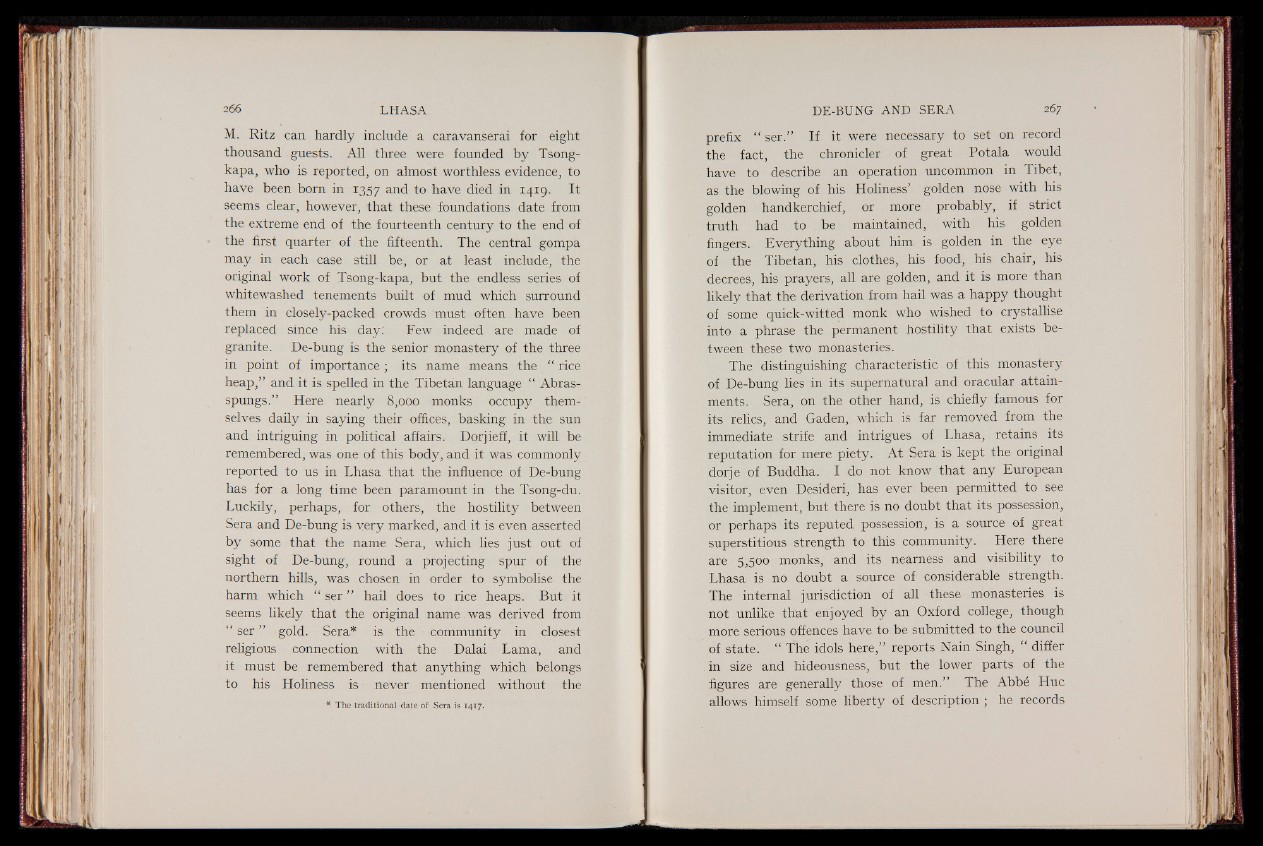
M. Ritz can hardly include a caravanserai for eight
thousand guests. All three were founded by Tsong-
kapa, who is reported, on almost worthless evidence, to
have been born in 1357 and to have died in 1419. It
seems clear, however, that these foundations date from
the extreme end of the fourteenth century to the end of
the first quarter of the fifteenth. The central gompa
may in each case still be, or at least include, the
original work of Tsong-kapa, but the endless series of
whitewashed tenements built of mud which surround
them in closely-packed crowds must often have been
replaced since his day: Few indeed are made of
granite. De-bung is the senior monastery of the three
in point of importance; its name means the “ rice
heap,” and it is spelled in the Tibetan language “ Abras-
spungs.” Here nearly 8,000 monks occupy themselves
daily in saying their offices, basking in the sun
and intriguing in political affairs. Dorjieff, it will be
remembered, was one of this body, and it was commonly
reported to us in Lhasa, that the influence of De-bung
has for a long time been paramount in the Tsong-du.
Luckily, perhaps, for others, the hostility between
Sera and De-bung is very marked, and it is even asserted
by some that the name Sera, which lies just out of
sight of De-bung, round a projecting sp u r ' of the
northern hills, was chosen in order to symbolise the
harm which “ ser ” hail does to rice heaps. But it
seems likely that the original name was derived from
“ ser ” gold. Sera* is the community in closest
religious connection with the Dalai Lama, and
it must be remembered that anything which belongs
to his Holiness is never mentioned without the
* The traditional date of Sera is 1417.
prefix “ ser.” If it were necessary to set on record
the fact, the chronicler of great Potala would
have to describe an operation uncommon in Tibet,
as the blowing of his Holiness’ golden nose with his
golden handkerchief, or more probably, if strict
truth had to be maintained, with his golden
fingers. Everything about him is golden in the eye
of the Tibetan, his clothes, his food, his chair, his
decrees, his prayers, all are golden, and it is more than
likely that the derivation from hail was a happy thought
of some quick-witted monk who wished to crystallise
into a phrase the permanent hostility that exists between
these two monasteries.
The distinguishing characteristic of this monastery
of De-bung lies in its supernatural and oracular attainments.
Sera, on the other hand, is chiefly famous for
its relics, and Gaden, which is far removed from the
immediate strife and intrigues of Lhasa, retains its
reputation for mere piety. At Sera is kept the original
dorje of Buddha. I do not know that any European
visitor, even Desideri, has ever been permitted to see
the implement, but there is no doubt that its possession,
or perhaps its reputed possession, is a source of great
superstitious strength to this community. Here there
are 5,500 monks, and its nearness and visibility to
Lhasa is no doubt a source of considerable strength.
The internal jurisdiction of all these monasteries is
not unlike that enjoyed by an Oxford college, though
more serious offences have to be submitted to the council
of state. “ The idols here,” reports Nain Singh, “ differ
in size and hideousness, but the lower parts of the
figures are generally those of men.” The Abbé Hue
allows himself some liberty of description ; he records